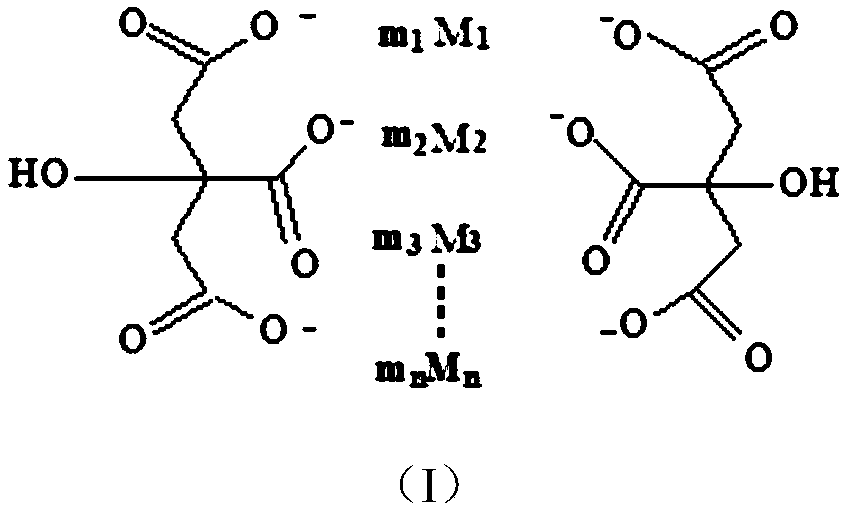Organic-inorganic self-solidified composite bone graft formed by hydration bridge formation of multi-trace element organic compound and inorganic compound
A bone graft and compound technology, applied in the field of biomedical materials, can solve the problems of small selectivity, disappearance, single function, etc.
- Summary
- Abstract
- Description
- Claims
- Application Information
AI Technical Summary
Problems solved by technology
Method used
Image
Examples
Embodiment 1
[0064] Experimental steps:
[0065] (1) Add 5000mL of pure water into a 10L glass reactor, stir under the protection of nitrogen, and gradually add 384.28 g of 3-hydroxy-1,3,5-pentanetriic acid. After it is completely dissolved, add in order: 125.42g ZnCO 3 ; After stirring for 20 minutes, add 200.18g CaCO 3 , stir and gradually raise the temperature to 60°C, adjust the pH value to 7.5-8.0 with ammonia water, then maintain for 4 hours, then gradually cool to room temperature naturally, seal the reactor and keep for 48 hours. Then the supernatant was removed by filtration, the precipitate was washed 4 times with 3000ml pure water, and then washed twice with 3000mL absolute ethanol, then dried at 120°C for 12 hours under the protection of nitrogen, and then dried at 100°C for 12 hours in a vacuum oven. Obtain 436.05 g of multi-trace element organic compound of structure shown in formula (I), in this formula (I) structural compound m 1 = 1, M 1 = Zn; m 2 = 2, M 2 = Ca; m 3...
Embodiment 2
[0074] Experimental steps:
[0075] (1) get the product 50g of (I) of anhydrous structure in the above-mentioned embodiment 1 and mix with 50g anhydrous calcium hydrogen phosphate, finely grind 2 hours by ball mill, obtain 96g to have structure (II) multi-trace element organic compound and inorganic Organic-inorganic self-solidifying composite bone graft formed by compound through hydration bridging, wherein M i = Ca, X = HPO 4 2- .
[0076] (2) Take 10g of the above structure (II) multi-trace element organic compound and inorganic compound organic-inorganic self-solidifying composite bone graft, add 5mL of pure water, stir, and after 3 minutes it becomes a dough state, and put it into a φ3×5mm mold , 30 minutes out. Hydration occurs by adding pure water, and the structure (II) is transformed into an organic-inorganic self-solidifying composite bone graft structure (III) formed by hydration bridging of multi-trace element organic compounds and inorganic compounds.
[0077...
Embodiment 3
[0084] Experimental steps:
[0085] (1) Add 5000mL of pure water into a 10L glass reactor, stir under nitrogen protection, and gradually add 384.28 g of 3-hydroxy-1,3,5-pentanetrionic acid. After it is completely dissolved, add 84g of MgCO 3 ; After stirring for 20 minutes, add 200.18g CaCO 3 , stir and gradually raise the temperature to 60°C, adjust the pH value to 7.5-8.0 with ammonia water, then maintain for 4 hours, then gradually cool to room temperature naturally, seal the reactor and keep for 48 hours. Then the supernatant was removed by filtration, the precipitate was washed 4 times with 3000ml pure water, and then washed twice with 3000mL absolute ethanol, then dried at 120°C for 12 hours under the protection of nitrogen, and then dried at 100°C for 12 hours in a vacuum oven. (I) of anhydrous structure was obtained: 420.12 g. m in (I) of the anhydrous structure of the multi-trace element organic compound1 = 1, M 1 = Mg; m 2 = 2, M 2 = Ca; m 3= 0, M 3 =0.
[00...
PUM
| Property | Measurement | Unit |
|---|---|---|
| Diameter | aaaaa | aaaaa |
Abstract
Description
Claims
Application Information
 Login to View More
Login to View More - R&D Engineer
- R&D Manager
- IP Professional
- Industry Leading Data Capabilities
- Powerful AI technology
- Patent DNA Extraction
Browse by: Latest US Patents, China's latest patents, Technical Efficacy Thesaurus, Application Domain, Technology Topic, Popular Technical Reports.
© 2024 PatSnap. All rights reserved.Legal|Privacy policy|Modern Slavery Act Transparency Statement|Sitemap|About US| Contact US: help@patsnap.com










